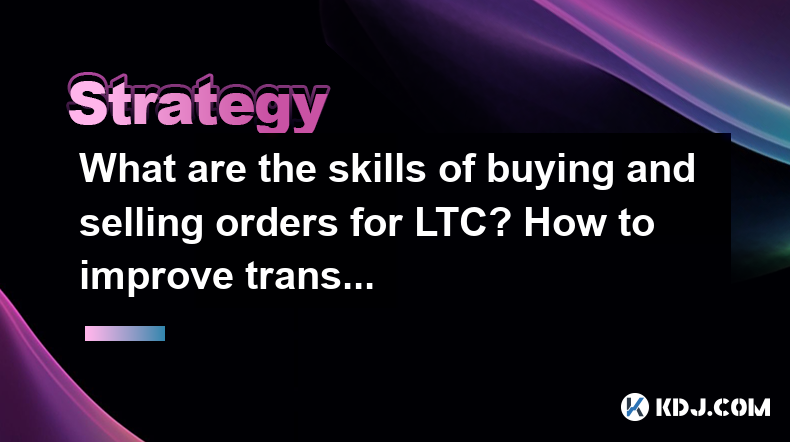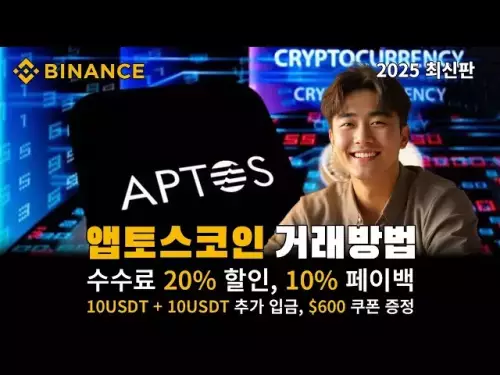-
 bitcoin
bitcoin $112715.707551 USD
-1.71% -
 ethereum
ethereum $4101.475385 USD
-3.01% -
 tether
tether $1.000644 USD
-0.02% -
 bnb
bnb $1207.619465 USD
-6.77% -
 xrp
xrp $2.501451 USD
-3.98% -
 solana
solana $202.947124 USD
-3.32% -
 usd-coin
usd-coin $1.000295 USD
0.04% -
 dogecoin
dogecoin $0.203884 USD
-4.47% -
 tron
tron $0.317154 USD
-1.72% -
 cardano
cardano $0.695009 USD
-4.43% -
 hyperliquid
hyperliquid $38.853961 USD
-8.23% -
 chainlink
chainlink $18.988674 USD
-4.64% -
 ethena-usde
ethena-usde $1.000233 USD
-0.03% -
 stellar
stellar $0.337050 USD
-3.63% -
 bitcoin-cash
bitcoin-cash $536.861728 USD
-1.28%
What are the skills of buying and selling orders for LTC? How to improve transaction efficiency?
To optimize LTC transactions, use market, limit, stop, and stop-limit orders, employ strategies like DCA and swing trading, and enhance efficiency with bots and technical analysis.
May 01, 2025 at 09:07 pm

Buying and selling Litecoin (LTC) involves understanding various order types and strategies to optimize your transactions. Whether you are a beginner or an experienced trader, improving transaction efficiency is crucial to maximizing profits and minimizing losses. This article will delve into the essential skills needed for buying and selling LTC orders and provide detailed guidance on how to enhance your transaction efficiency.
Understanding Different Order Types
When trading LTC, you have several types of orders at your disposal. Each type serves a specific purpose and can be used to achieve different trading goals.
Market Orders: These are the simplest type of order. When you place a market order, you buy or sell LTC at the current market price. Market orders are executed immediately, ensuring that your trade is completed quickly. However, the price you get may differ from the price you see when you place the order, especially in volatile markets.
Limit Orders: A limit order allows you to specify the price at which you want to buy or sell LTC. If the market reaches your specified price, the order will be executed. Limit orders give you more control over the price but do not guarantee execution, as the market may never reach your specified price.
Stop Orders: A stop order becomes a market order once a specified price level is reached. For example, a stop-loss order is used to limit losses by selling LTC when its price falls to a certain level. Conversely, a stop-buy order can be used to buy LTC when its price rises to a certain level, potentially locking in profits.
Stop-Limit Orders: This type of order combines the features of a stop order and a limit order. Once the stop price is reached, the order becomes a limit order, which is executed at the specified limit price or better. Stop-limit orders offer more control than stop orders but may not be executed if the market moves rapidly through the specified price levels.
Strategies for Buying and Selling LTC
To effectively buy and sell LTC, you need to employ various strategies that align with your trading goals and risk tolerance.
Dollar-Cost Averaging (DCA): This strategy involves investing a fixed amount of money at regular intervals, regardless of the market price. DCA helps to reduce the impact of volatility by spreading out your purchases over time. For example, you might decide to invest $100 in LTC every week, buying more coins when the price is low and fewer when the price is high.
Swing Trading: Swing trading involves holding LTC for a short period, typically a few days to a few weeks, to capitalize on price swings. This strategy requires a good understanding of market trends and technical analysis to identify entry and exit points.
Scalping: Scalping is a strategy that involves making numerous trades throughout the day to profit from small price movements. This approach requires a high level of attention and quick decision-making, as well as a good understanding of market dynamics.
HODLing: HODLing is a long-term investment strategy where you buy LTC and hold onto it for an extended period, regardless of short-term market fluctuations. This strategy is based on the belief that the value of LTC will increase over time.
Improving Transaction Efficiency
Improving transaction efficiency is crucial for maximizing your returns when buying and selling LTC. Here are some tips to enhance your trading efficiency:
Choose the Right Exchange: The exchange you use can significantly impact your transaction efficiency. Choose an exchange that offers low fees, high liquidity, and a user-friendly interface. Popular exchanges for LTC include Coinbase, Binance, and Kraken.
Use Trading Bots: Trading bots can help automate your trading strategy, allowing you to execute trades more efficiently. Bots can monitor the market 24/7 and execute trades based on predefined criteria. However, it's essential to choose a reputable bot and understand its functionality before using it.
Optimize Your Order Placement: When placing orders, consider using limit orders to get better prices, especially in volatile markets. Also, be mindful of the order size; large orders can move the market, potentially resulting in less favorable prices.
Monitor Fees: Transaction fees can eat into your profits. Monitor the fees associated with buying and selling LTC, including trading fees, withdrawal fees, and any other charges. Opt for exchanges with competitive fee structures to maximize your returns.
Stay Informed: Keeping up with market news and developments can help you make more informed trading decisions. Stay informed by following reputable cryptocurrency news sources, joining online communities, and using market analysis tools.
Technical Analysis for LTC Trading
Technical analysis is a critical skill for improving your transaction efficiency when trading LTC. Here are some key concepts and tools to master:
Candlestick Charts: Candlestick charts provide a visual representation of price movements over time. Each candlestick shows the opening, closing, high, and low prices for a specific period. Understanding candlestick patterns can help you predict future price movements.
Moving Averages: Moving averages smooth out price data to identify trends over time. Common types include the simple moving average (SMA) and the exponential moving average (EMA). Using moving averages can help you identify potential entry and exit points.
Relative Strength Index (RSI): The RSI is a momentum oscillator that measures the speed and change of price movements. An RSI above 70 indicates that an asset may be overbought, while an RSI below 30 suggests it may be oversold. This tool can help you identify potential reversal points.
Support and Resistance Levels: Support and resistance levels are price levels where the market tends to reverse direction. Identifying these levels can help you make more informed trading decisions, such as setting stop-loss orders or taking profits.
Risk Management in LTC Trading
Effective risk management is essential for improving transaction efficiency and protecting your investments. Here are some key risk management strategies:
Set Stop-Loss Orders: Stop-loss orders can help limit your losses by automatically selling LTC when its price falls to a certain level. Setting appropriate stop-loss levels can help protect your capital and prevent significant losses.
Diversify Your Portfolio: Diversifying your portfolio by investing in multiple cryptocurrencies can help spread risk. While LTC may be a significant part of your portfolio, consider allocating funds to other assets to reduce the impact of any single investment's performance.
Use Position Sizing: Position sizing involves determining the amount of capital to allocate to each trade based on your risk tolerance. This strategy can help you manage risk by ensuring that no single trade can significantly impact your overall portfolio.
Avoid Emotional Trading: Emotional trading can lead to impulsive decisions that result in losses. Stick to your trading plan and avoid making decisions based on fear or greed. Maintaining discipline and following your strategy can help improve your transaction efficiency.
Practical Steps for Buying and Selling LTC
To help you get started with buying and selling LTC, here are detailed steps for executing trades on a typical cryptocurrency exchange:
Create an Account:
- Visit the website of your chosen exchange and click on the 'Sign Up' or 'Register' button.
- Fill out the required information, including your name, email address, and a strong password.
- Complete the verification process, which may involve submitting identification documents.
Deposit Funds:
- Log in to your account and navigate to the 'Deposit' section.
- Choose the currency you want to deposit (e.g., USD, EUR) and follow the instructions to transfer funds from your bank account or another payment method.
- Wait for the funds to be credited to your exchange account.
Place an Order:
- Navigate to the LTC trading page on the exchange.
- Choose the type of order you want to place (market, limit, stop, or stop-limit).
- Enter the amount of LTC you want to buy or sell and the price (if applicable).
- Review your order and click 'Submit' to place it.
Monitor Your Trade:
- Keep an eye on the market and your order status.
- If you placed a limit order, wait for the market to reach your specified price.
- Once your order is filled, you can see the details in your transaction history.
Withdraw Your LTC:
- If you want to move your LTC to a private wallet, navigate to the 'Withdraw' section.
- Enter the amount of LTC you want to withdraw and the address of your wallet.
- Review the withdrawal details and click 'Submit' to initiate the transfer.
Frequently Asked Questions
Q: Can I trade LTC on weekends?A: Yes, many cryptocurrency exchanges operate 24/7, allowing you to trade LTC at any time, including weekends. However, liquidity may vary, so be mindful of potential price slippage.
Q: What is the minimum amount of LTC I can buy?A: The minimum amount of LTC you can buy depends on the exchange and the type of order you place. Some exchanges allow you to buy fractional amounts of LTC, while others may have a minimum purchase requirement.
Q: How do I store my LTC securely?A: To store your LTC securely, consider using a hardware wallet, such as Ledger or Trezor, which keeps your private keys offline. Alternatively, you can use a reputable software wallet or the wallet provided by your exchange, but be aware that these options may be less secure.
Q: Are there any tax implications when buying and selling LTC?A: Yes, buying and selling LTC can have tax implications, depending on your country of residence. In many jurisdictions, profits from cryptocurrency trading are subject to capital gains tax. It's essential to consult with a tax professional to understand your obligations.
Disclaimer:info@kdj.com
The information provided is not trading advice. kdj.com does not assume any responsibility for any investments made based on the information provided in this article. Cryptocurrencies are highly volatile and it is highly recommended that you invest with caution after thorough research!
If you believe that the content used on this website infringes your copyright, please contact us immediately (info@kdj.com) and we will delete it promptly.
- MEXC's Explosive Growth: Trading Volume and Token Gains in Focus
- 2025-10-15 18:25:16
- Pudgy Penguins Price Prediction: Bull Flag Hints at Breakout!
- 2025-10-15 18:45:14
- GateToken Q3 2025 Onchain Destruction: Deflationary Strategy in Action
- 2025-10-15 18:45:14
- Chainlink (LINK): Super Bullish Signals Amidst Institutional Adoption
- 2025-10-15 18:25:16
- Arbitrum (ARB) Comeback: Is a Price Surge on the Horizon?
- 2025-10-15 19:05:12
- Coinbase's India Crypto Play: A Bullish Bet on CoinDCX and the Future of Digital Assets
- 2025-10-15 18:30:01
Related knowledge

Practical parameter settings for a Bitcoin multi-timeframe moving average system
Sep 18,2025 at 10:54pm
Optimizing Timeframe Combinations for Bitcoin Trading1. Selecting appropriate timeframes is crucial when building a multi-timeframe moving average sys...

How can I filter out false breakouts in Dogecoin high-frequency trading?
Sep 22,2025 at 01:00am
Understanding False Breakouts in Dogecoin Trading1. A false breakout occurs when Dogecoin's price appears to move beyond a defined support or resistan...

Techniques for identifying tops and bottoms in the Bitcoin on-chain NVT model
Sep 20,2025 at 07:54pm
Understanding the NVT Model in Bitcoin Analysis1. The Network Value to Transactions (NVT) ratio is often described as the 'P/E ratio' of the cryptocur...

What does the surge in open interest in Bitcoincoin futures mean?
Sep 20,2025 at 11:18pm
Understanding the Surge in Dogecoin Futures Open Interest1. A surge in open interest within Dogecoin futures indicates a growing number of active cont...

How can I use the Ethereum USDT premium to gauge market sentiment?
Sep 18,2025 at 11:55pm
Understanding the Ethereum USDT Premium1. The Ethereum USDT premium refers to the price difference between USDT (Tether) traded on Ethereum-based plat...

What should I do if Ethereum staking yields decline?
Sep 20,2025 at 06:18am
Understanding the Causes Behind Declining Ethereum Staking Yields1. The Ethereum network transitioned to a proof-of-stake consensus mechanism with the...

Practical parameter settings for a Bitcoin multi-timeframe moving average system
Sep 18,2025 at 10:54pm
Optimizing Timeframe Combinations for Bitcoin Trading1. Selecting appropriate timeframes is crucial when building a multi-timeframe moving average sys...

How can I filter out false breakouts in Dogecoin high-frequency trading?
Sep 22,2025 at 01:00am
Understanding False Breakouts in Dogecoin Trading1. A false breakout occurs when Dogecoin's price appears to move beyond a defined support or resistan...

Techniques for identifying tops and bottoms in the Bitcoin on-chain NVT model
Sep 20,2025 at 07:54pm
Understanding the NVT Model in Bitcoin Analysis1. The Network Value to Transactions (NVT) ratio is often described as the 'P/E ratio' of the cryptocur...

What does the surge in open interest in Bitcoincoin futures mean?
Sep 20,2025 at 11:18pm
Understanding the Surge in Dogecoin Futures Open Interest1. A surge in open interest within Dogecoin futures indicates a growing number of active cont...

How can I use the Ethereum USDT premium to gauge market sentiment?
Sep 18,2025 at 11:55pm
Understanding the Ethereum USDT Premium1. The Ethereum USDT premium refers to the price difference between USDT (Tether) traded on Ethereum-based plat...

What should I do if Ethereum staking yields decline?
Sep 20,2025 at 06:18am
Understanding the Causes Behind Declining Ethereum Staking Yields1. The Ethereum network transitioned to a proof-of-stake consensus mechanism with the...
See all articles


























![Staking ATH: How To Stake $ATH in October 2025 with 523% APY — [Step-By-Step Guide] Staking ATH: How To Stake $ATH in October 2025 with 523% APY — [Step-By-Step Guide]](/uploads/2025/10/15/cryptocurrencies-news/videos/staking-ath-stake-ath-october-apy-stepstep-guide/68eef94d80903_image_500_375.webp)















































